Pump Handbook by Igor J. Karassik, Joseph P. Messina, Paul Cooper, Charles C. Heald - 3rd edition
Подождите немного. Документ загружается.

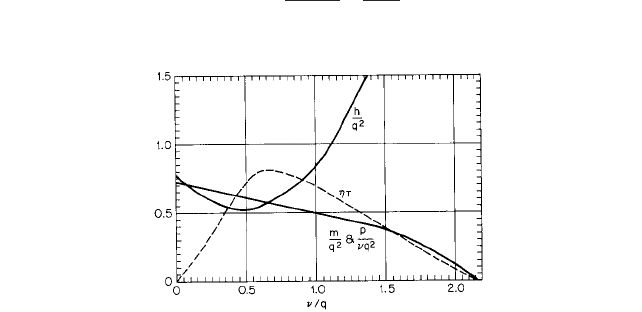
2.3.1 CENTRIFUGAL PUMPS: GENERAL PERFORMANCE CHARACTERISTICS 2.385
FIGURE 60 Dimensionless characteristic curves for DeLaval L 10/8 pump, constant-discharge turbine operation
(Reference 63)
*It is assumed that turbine mode characteristics of the proposed pump are not available when the initial selection is
made.
ciency h
i
h/h
m
be used instead of the hydraulic efficiency h
h
in Eq. 45. The mechanical
efficiency h
m
will probably be very high for both model and prototype for most cases of
interest, so good results should be obtained if the overall efficiency is used in Eq. 36.
Model-prototype geometric similarity should include surface finish and wearing ring or
tip clearances, but this may be difficult or impossible to achieve.Anderson (see Section 2.1:
Figure 10 and Reference 6) proposed a method that includes a correction for dissimilarity
in surface finish.
OPERATION OF PUMPS AS TURBINES __________________________________
Centrifugal pumps may be used as hydraulic turbines in some cases where low first cost is
paramount. Because the pump has no speed-regulating mechanism, considerable speed
variation must be expected unless the head and load remain very nearly constant. Some
speed control could be obtained by throttling the discharge automatically, but this would
increase the cost, and the power lost in the throttle valve would lower the overall efficiency.
Pump Selection After the head, speed, and power output of the turbine have been spec-
ified, it is necessary to select a pump that, when used as a turbine, will satisfy the require-
ments. Assuming that performance curves for a series of pumps are available*, a typical
set of such curves should be normalized using the head, power, and flow rate of the best
efficiency point as normal values. These curves will correspond to the right part of Sec-
tion 1 of either Figure 52 or 53. In normalizing the power P, let p P/P
n
and the curve of
p/n
3
will be identical with the curve of m/n
2
in Figure 52 or 53. The normalized curves may
be compared with the curves in Sections 1 of Figures 52 and 53 to determine which curves
best represent the characteristics of the proposed pump. When a choice has been made,
the approximate turbine performance can be obtained from the corresponding figure of
Figures 60 to 63.
EXAMPLE Assume that the turbine specifications are H
T
20 ft, P
T
12.75 hp and n
580 rpm, and that the characteristics of the DeLaval L1O/8 pump are representative
of a series of pumps from which a selection can be made. The turbine discharge Q
T
in
gallons per minute after substituting the above values is
(39)Q
T
3960P
T
H
T
h
T
2520
h
T
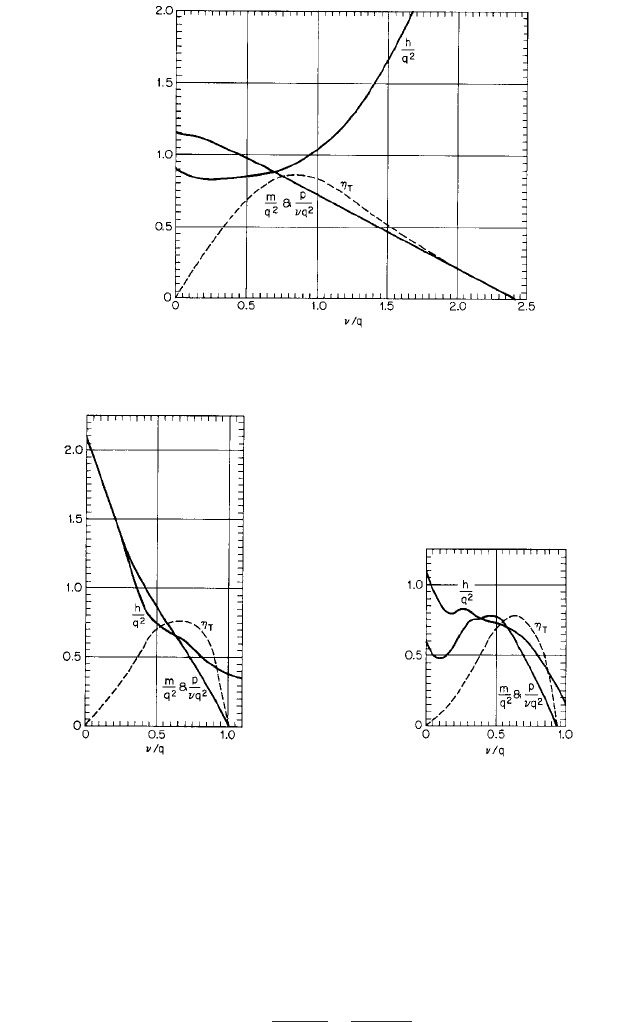
2.386 CHAPTER TWO
FIGURE 61 Dimensionless characteristic curves for Voith pump, constant-discharge turbine operation
(Reference 63)
FIGURE 62 Dimensionless characteristics curves for
Peerless 10MH pump, constant-discharge turbine
operation (Reference 63)
FIGURE 63 Dimensionless characteristic curves for
Peerless 10PL pump, constant-discharge turbine
operation (Reference 63)
where h
T
is turbine efficiency, shown in Figure 60. Only the normal values Q
n
,H
n
P
n
,
and so on, are common to the curves of both Figures 52 and 60, so these alone can be
used in selecting the required pump.Values of n/q,h/q
2
, and h
T
are read from the curves
of Figure 60 and corresponding values of Q computed by Eq. 39. Values of Q
n
and H
n
are
then given by
(40)
(41)H
n
H1n>q2
2
h>q
2
201n>q2
2
h>q
2
Q
n
Q1n>q2
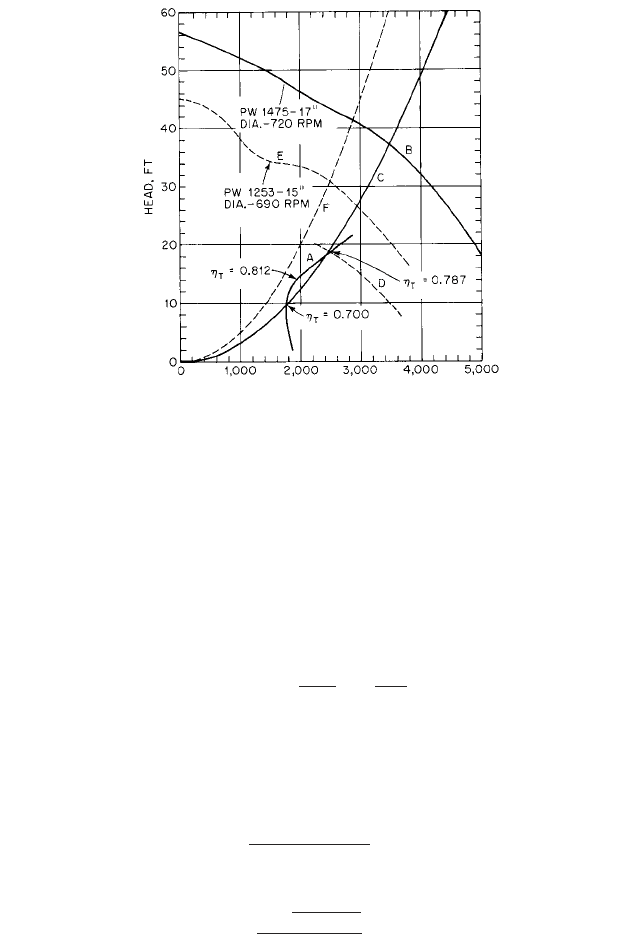
2.3.1 CENTRIFUGAL PUMPS: GENERAL PERFORMANCE CHARACTERISTICS 2.387
FLOW RATE, GPM
FIGURE 64 Head-flow curves of the pump selection (ft 0.3048 = m; gpm 0.06300 = l/s) (Reference 63)
For example, in Figure 60 at n/q 0.700, read h/q
2
0.595 and h
T
0.805. By Eq. 39,
Q
T
2520/0.805 3130 gpm; by Eq. 40, Q
n
(3130)(0.700) 2190 gpm; and by Eq.
41, H
n
(20)(0.700)
2
/0.9595 16.5 ft. In a similar manner, the locus of the best effi-
ciency points for an infinite number of pumps, each having the same characteristics as
shown in Figures 52 and 60, is obtained, and each pump would satisfy the turbine
requirements. This locus of best efficiency points is plotted as curve A in Figure 64.
The head curve for a DeLaval L 16/14 pump having a 17-in-diameter impeller
tested at 720 rpm is shown as curve B in Figure 64.The best efficiency point was found
to be at Q
n
3500 gpm and H
n
37.2 ft. The locus of the best efficiency points for this
pump for different speeds and impeller diameters is given by Eqs. 12 as
(42)
and is shown by curve C in Figure 64. Curve C intersects curve A at two points, show-
ing that the L 16/14 pump satisfies the turbine requirements. Only the intersection at
the higher turbine efficiency is of interest. At this point, Q
n
2490 gpm and H
n
18.8
ft. Because the turbine speed was specified to be 580 rpm, the required impeller diam-
eter is given by Eqs. 12 as
or by
The computed head curve for the 15-in-diameter impeller at 580 rpm is shown as
curve D in Figure 64. The turbine discharge is 3200 gpm from Eq. 39 with h
T
0.787.
The optimum solution would be to have Curve C tangent to Curve A at the point
corresponding to maximum turbine efficiency, in this case h
T
0.812. Because this
D
17118.8>37.2
580>720
15 in
D
117212490>35002
580>720
15 in
H
n
37.2 a
Q
n
3500
b
2
3.04
10
6
Q
n
2
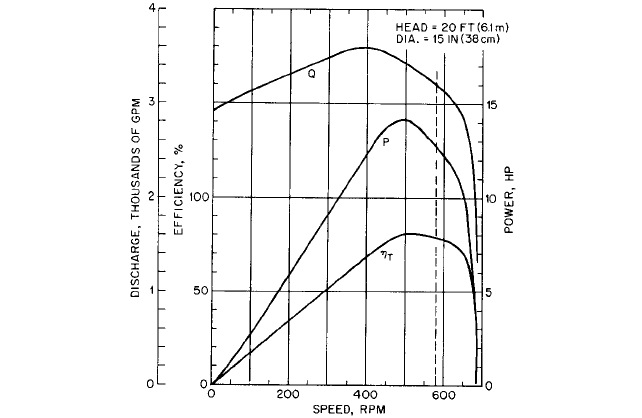
2.388 CHAPTER TWO
FIGURE 65 Computed constant-head turbine characteristics for DeLaval L 16/14 pump (gpm 0.06309 = l/s; hp
0.7457 = kW) (Reference 63)
would require a smaller pump, Curve E in Figure 64 shows a head curve for a K 14/12
pump, which was the next smaller pump in the series. Curve F, the locus of the best
efficiency points, does not intersect Curve A, showing that the smaller pump will not
satisfy the turbine requirements. It is important to note that the turbine head, 20 ft,
specified for this example was assumed to be the net head from the inlet to outlet
flange of the pump when installed and operated as a turbine.
The procedure outlined above should lead to the selection of a pump large enough to
provide the required power. However, it probably will be necessary to apply the affinity
laws over such wide ranges of the variables that the usual degree of accuracy should not
be expected. Considerable care should be exercised if it becomes necessary to interpolate
between the curves of Figures 60 to 63. The computed performance will very likely differ
from the results of subsequent tests.The curves of Figure 60 may be converted to show the
constant-head characteristics of the L 16/14 pump when installed and operated as a tur-
bine. Details of the method of computation are given in Reference 63, and the computed
characteristics are shown in Figure 65.
A comprehensive study by Acres American
64,65
led to a computer program to aid in
selecting a pump to meet specific requirements when operating in the turbine mode.
Known pump characteristics are entered in the program according to a specified format.
The computer compares them with stored characteristics of pumps for which turbine mode
characteristics are known and provides estimated turbine mode characteristics for the
proposed pump. Vols. I and III of Reference 64 describe the method of computation and
give complete instructions for using the program.
Optimized Hydraulic Turbines A logical outgrowth of applying pumps as hydraulic tur-
bines is the optimization of these machines as turbines. Several points of efficiency
improvement have been demonstrated over that of pumps running in reverse as tur-
bines.
66
The fluid accelerates through both the stator or nozzles and the turbine wheel or
runner, whereas it decelerates through the same elements when they are acting as
impeller and diffuser or volute in the pumping mode. If the fluid never has to decelerate
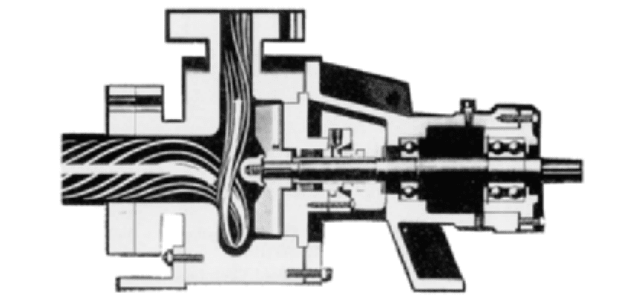
2.3.1 CENTRIFUGAL PUMPS: GENERAL PERFORMANCE CHARACTERISTICS 2.389
FIGURE 66 Vortex pump (courtesy Fybroc Division, METPRO)
*See also Section 9.2.
because the turbine will never be used as a pump, the nozzles and runner can be designed
to produce more aggressive and efficient acceleration in shorter distances than if the same
machine is simply a pump being used as a turbine. If it is a radial-inflow runner, the
resulting optimized turbine wheel employs a radial blade (with a blade angle b 90 deg.
from the tangential direction) at the outer diameter (inlet). This outer diameter is about
75% of the diameter of the impeller of the pump-as-turbine, which further improves the
efficiency by reason of the reduction of the disk friction drag of the runner. Design and
application of both approaches is explained and compared in Reference 67. Many of the
applications of these hydraulic turbines are for power recovery in the pressure let-down
processes that occur in petroleum refining. Another variable is introduced in such
processes; namely, the evolution of large volumes of dissolved gas as the pressure
decreases through successive stages or portions of the turbine. This phenomenon affects
the performance of hydraulic turbines for such applications because somewhat more
power is produced when gas evolves from the liquid than when a single-phase liquid flows
through the turbine at the same pressure drop and mass flow rate.
68
VORTEX PUMPS _____________________________________________________
A typical vortex pump is shown in Figure 66.* The ability of this type of pump to handle
relatively large amounts of suspended solids as well as entrained air or gas more than off-
sets the relatively low efficiency. Table 10 lists performance data for four typical vortex
pumps and four radial-flow centrifugal pumps of nearly the same head and flow rate. Fig-
ure 67 shows the head characteristics of a typical vortex pump with impellers of different
diameters together with curves of constant efficiency and constant NPSH. Power curves
for the same impellers are shown in Figure 68.
Curves for a conventional radial-flow pump have been added for comparison in Figures
67 and 68. Note that the head of the vortex pump does not decrease as rapidly with an
increasing flow rate as does the head of the conventional pump.The power requirement of
the vortex pump increases almost linearly with an increasing flow rate, whereas the power
required by a conventional pump of about the same specific speed reaches a maximum and
then decreases with the increasing flow rate.
Thus if the motor of the vortex pump has been selected to match the power required at
the normal flow rate for best efficiency, it will be overloaded if the pump operates much
beyond that point.
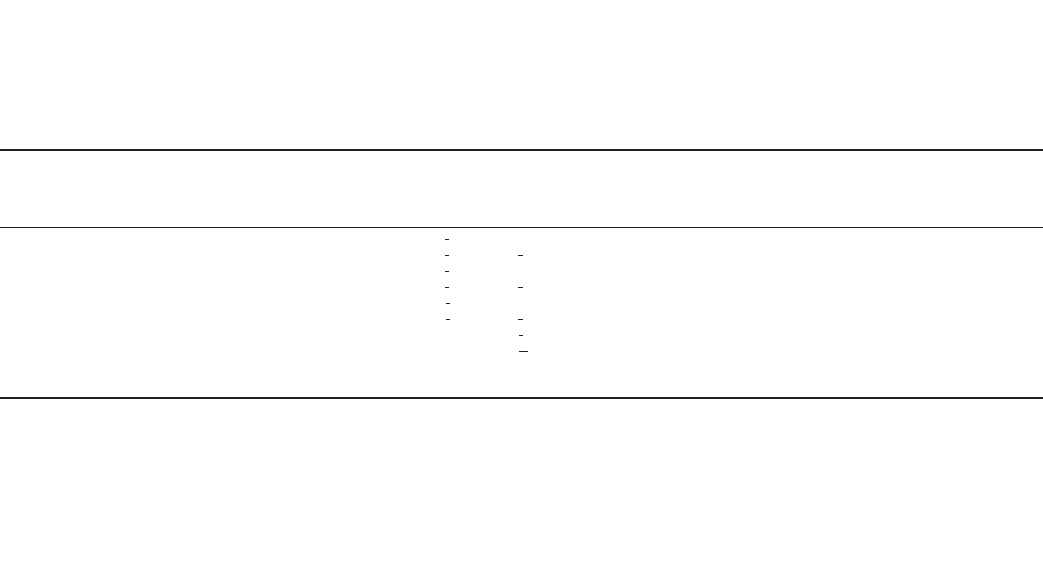
2.390
TABLE 10 Characteristics of typical vortex pumps and comparable radial-flow centrifugal pumps at 1750 rpm
Power
b
Head
b
Specific Suction Impeller Sphere Efficiency
b
Shutoff at Shutoff at NPSHR
b
NPSHR
b
Flow rate, Total head, speed, specific speed, diameter, diameter,
a
at Q power,
b
1.5Q
n
, head,
b
1.5Q
n
, at Q
n
,at 1.5Q
n
,
Impeller gpm (l/s) ft (m) n
s
(
s
) S (
ss
) in (mm) in (mm) Q
n
,% %P
n
%P
n
%H
n
%H
n
ft (m) ft (m)
Vortex 100 (6.3) 24 (7.3) 1614 (0.591) 7700 (2.82) 5 (149) 2 (51) 39.5 37.5 131 120 71 3 (0.9) 8 (2.4)
Radial 108 (6.8) 26 (7.9) 1580 (0.578) 6430 (2.35) 5 (149) (16) 59 50 108 144 50 4 (1.2) 7.5 (2.3)
Vortex 200 (12.6) 61 (18.6) 1134 (0.415) 7400 (2.71) 8 (213) 2 (51) 45 45 129 123 82 5 (1.5) 8 (2.4)
Radial 225 (14.2) 60 (18.3) 1218 (0.446) 6450 (2.36) 8 (213) (19) 61 50 130 125 65 6.5 (2.0) 14 (3.4)
Vortex 850 (53.6) 108 (32.9) 1523 (0.557) 9820 (3.59) 11 (292) 4 (102) 59 49 134 120 83 9 (2.7) 15 (4.6)
Radial 900 (56.8) 102 (31.1) 1636 (0.599) 8690 (3.18) 11 (292) (22) 76 47 113 135 44 11 (3.4) 21 (6.1)
Vortex 1050 (66.2) 150 (45.7) 1323 (0.484) 7088 (2.59) 13 (330) 3 (95) 56 48 137 115 87 16 (4.9) 20 (6.1)
Radial 1250 (78.9) 154 (46.9) 1415 (0.518) 13 (330) 1 (26) 83 52 123 116 45 11 (3.4) - (-)
Vortex average 1399 (0.512) 50 45 133 120 81
Radial average 1462 (0.535) 70 50 119 130 51
a
Diameter of the largest sphere that will pass through the pump
b
Subscript n designates values at the best efficiency point
1
32
3
4
7
8
1
2
1
2
3
4
3
8
3
8
5
8
7
8
7
8
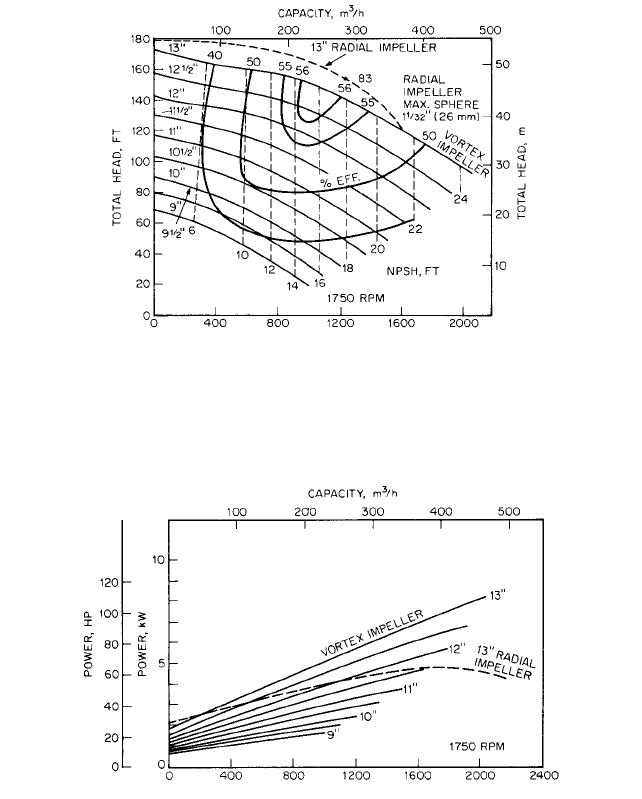
2.3.1 CENTRIFUGAL PUMPS: GENERAL PERFORMANCE CHARACTERISTICS 2.391
FLOW RATE, GPM
FLOW RATE, GPM
FIGURE 68 Power characteristics of a typical vortex pump. Curves show approximate characteristics when
pumping clear water (in 2.54 = cm) (Flowserve Corporation).
REFERENCES _______________________________________________________
1. Pfleiderer, C. Die Kreiselpumpen für Flüssigkeiten und Gase. 5
te
Auflage, Springer-
Verlag, 1961.
2. Gülich, J., Favre, J. N., and Denus, K. “An Assessment of Pump Impeller Performance
Predictions by 3D-Navier Stokes Calculations.” Third International Symposium on
Pumping Machinery (S239), ASME Fluids Engineering Division Summer Meeting,
Paper No. FEDSM97-3341, June 1997.
FIGURE 67 Head characteristics of a typical vortex pump. Curves show approximate characteristics when
pumping clear water (in 2.54 = cm) (Flowserve Corporation).
2.392 CHAPTER TWO
3. Rupp, W. E. High Efficiency Low Specific Speed Centrifugal Pump. U.S. Patent No.
3,205,828, September 14, 1965.
4. Barske, U. M. “Development of Some Unconventional Centrifugal Pumps.” Proc. Inst.
Mech. Eng., London, 174(11):437, 1960.
5. Manson, W. W. “Experience with Inlet Throttled Centrifugal Pumps, Gas Turbine
Pumps.” Cavitation in Fluid Machinery, Symposium Publication,ASME, 1972, pp. 21
—
27.
6. Wislicenus, C. F. “Critical Considerations on Cavitation Limits of Centrifugal and
Axial-Flow Pumps.” Trans ASME, 78:1707, 1956.
7. Karassik, I. J., and Carter, R. Centrifugal Pumps: Selection, Operation and Mainte-
nance. McGraw-Hill, New York, 1960.
8. Holland, F. A., and Chapman, F. S. Pumping of Liquids. Reinhold, New York, 1966.
9. Ippen, A. T. “The Influence of Viscosity on Centrifugal Pump Performance.” Trans.
ASME, 68(8):823, 1946.
10. Black, H. F., and Jensen, D. N. “Effects of High-Pressure Ring Seals on Pump Rotor
Vibrations.” ASME Paper No. 71-WA/FF-38, 1971.
11. Wood, C. M., Welna, H., and Lamers, R. P. “Tip-Clearance Effects in Centrifugal
Pumps.” Trans. ASME, J. Basic Eng., Series D, 89:932, 1965.
12. Stepanoff, A. J. Centrifugal and Axial Flow Pumps, 2nd ed., Krieger Publishing, Mal-
abar, FL, 1957.
13. Rütschi, K. “Untersuchungen an Spiralgehäusepumpen veraschiedener Schnelläu-
figkeit,” Schweiz. Arch Angew, Wiss. Tech. 17(2):33, 1951.
14. Stepanoff, A. J. Pumps and Blowers: Two Phase Flow. Krieger Publishing, Malabar,
FL, 1965.
15. Knapp, R. T. “Recent Investigations of the Mechanics of Cavitation and Cavitation
Damage.” Trans. ASME 77:1045, 1955.
16. Knapp, R. T. “Cavitation Mechanics and Its Relation to the Design of Hydraulic Equip-
ment.” James Clayton, Lecture, Proc. Inst. Mech. Eng., London, Sec. A, 166:150, 1952.
17. Shutler, N. D., and Mesler, R. B. “A Photographic Study of the Dynamics and Damage
Capabilities of Bubbles Collapsing Near Solid Boundaries.” Trans. ASME, J. Basic
Eng., Series D, 87:511, 1965.
18. Hickling, R., and Plesset, M. S. “The Collapse of a Spherical Cavity in a Compressible
Liquid.” Division of Engineering and Applied Sciences, Report No. 85-24, California
Institute of Technology, March 1963.
19. Pilarczyk, K., and Rusak, V. “Application of Air Model Testing in the Study of Inlet
Flow in Pumps.” Cavitation in Fluid Machinery, ASME, 1965, p. 91.
20. Plesset, M. S. “Temperature Effects in Cavitation Damage.” Trans. ASME, J. Basic
Eng., Series D, 94:559, 1972.
21. Hammitt, F. C. “Observations on Cavitation Damage in a Flowing System.” Trans.
ASME, J. Basic Eng., Series D, 85:347 (1963).
22. Preece, C. M., ed. Treatise on Materials Science and Technology. Vol. 16, Erosion, Aca-
demic Press, New York, 1979.
23. Kovats, A. Design and Performance of Centrifugal and Axial Flow Pumps and Com-
pressors. Macmillan, New York, 1964.
24. Palgrave, R., and Cooper, P. “Visual Studies of Cavitation in Pumping Machinery.” Pro-
ceedings of the Third International Pump Symposium, Texas A&M University, 1986,
pp. 61
—
68.
25. Cooper, P., Sloteman, D. P., Graf, E., and Vlaming, D. J. “Elimination of Cavitation-
Related Instabilities and Damage in High-Energy Pump Impellers.” Proceedings of the
Eighth International Pump Users Symposium, Texas A&M University, 1991, pp. 3
—
19.
2.3.1 CENTRIFUGAL PUMPS: GENERAL PERFORMANCE CHARACTERISTICS 2.393
26. Vlaming, D. J. “Optimum Impeller Inlet Geometry for Minimum NPSH Requirements
for Centrifugal Pumps.” Pumping Machinery
—
1989, ASME, July 1989, pp. 25
—
29.
27. Hydraulic Institute ANSI/HI 2000 Edition Pump Standards, Hydraulic Institute, Par-
sippany, NJ www.pumps.org.
28. “Centrifugal Pumps.” PTC 8.2-1965, American Society of Mechanical Engineers, New
York, 1965.
29. Wislicenus, C. F., Watson, R. M., and Karassik, I. J. “Cavitation Characteristics of Cen-
trifugal Pumps Described by Similarity Considerations.” Trans. ASME 61:17, 1939;
62:155, 1940.
30. Stahl, H. A., and Stepanoff, A. J. “Thermodynamic Aspects of Cavitation in Centrifu-
gal Pumps.” Trans. ASME 78:1691, 1956.
31. Salemann, V. “Cavitation and NPSH Requirements of Various Liquids.” Trans. ASME,
J. Basic Eng., Series D, 81:167, 1959.
32. Stepanoff, A. J. “Cavitation Properties of Liquids.” Trans. ASME, J. Eng. Power, Series
A, 86:195, 1964.
33. Cooper, P. “Analysis of Single- and Two-Phase Flows in Turbopump Inducers.” Trans-
actions of the ASME, Series A, Vol. 89, 1967, pp. 577
—
588.
34. Lazarkiewicz, S., and Troskola ski, A. T. Impeller Pumps, Pergamon Press, New
York, 1965.
35. Gongwer, C. A. “A Theory of Cavitation Flow in Centrifugal-Pump Impellers.” Trans.
ASME, 63:29, 1941.
36. Guelich, J. F. Guidelines for Prevention of Cavitation in Centrifugal Feedpumps. EPRI
CS-6398, 1989.
37. ASTM Standard G-32. Cavitation Erosion Using Vibratory Apparatus, American Soci-
ety for Testing Materials, 1992.
38. Cooper, P., and Antunes, F. F. “Cavitation Damage in Boiler Feed Pumps.” Symposium
Proceedings: Power Plant Feed Pumps
—
The State of the Art, EPRI CS-3158, July 1983,
pp. 2
—
24 to 2
—
49.
39. Cooper, P., Sloteman, D. P., and Dussourd, J. L.“Stabilization of the Off-Design Behav-
ior of Centrifugal Pumps and Inducers.” Proceedings of the Second European Congress
on Fluid Machinery for the Oil, Petrochemical and Related Industries, I Mech E Con-
ference Publications, 1984-2, Paper No. C41/84, 1984, pp. 13
—
20.
40. Stripling, L. B., and Acosta, A. J. “Cavitation in Turbopumps
—
Part 1.” Transactions of
the ASME, Series D, Vol. 84, 1962, pp. 326
—
338.
41. Stripling, L. B.“Cavitation in Turbopumps
—
Part 2.” Transactions of the ASME, Series
D, Vol. 84, 1962, pp. 339
—
350.
42. Grohmann, M. “Extend Pump Application with Inducers.” Hydrocarbon Processing,
Dec. 1979, p. 121.
43. Doolin, J. H.“Centrifugal Pumps and Entrained Air Problems.” Pump World, 4(3), 1978.
44. Mechanical Engineering. 93(6):89, 1971.
45. Kittredge, C. P. “Hydraulic Transients in Centrifugal Pump Systems.” Trans. ASME,
78(6):1807, 1956.
46. Parmakian, J. Waterhammer Analysis. Prentice-Hall, Englewood Cliffs, NJ, 1955.
47. Streeter, V. L., and Wylie, E. B. Hydraulic Transients. McGraw-Hill, New York, 1967.
48. Bergeron, L. Waterhammer in Hydraulics and Wave Surges in Electricity. Wiley, New
York, 1961.
49. Addison, H. Centrifugal and Other Rotodynamic Pumps. 3rd ed. Chapman & Hall,
London, 1966.
n
¿
2.394 CHAPTER TWO
50. Richardson, C. A. “Economics of Electric Power Pumping.” Allis-Chalmers Elec. Rev.
9:20, 1944.
51. Fraser, W. H. “Flow Recirculation in Centrifugal Pumps.” Tenth Turbomachinery Sym-
posium. Texas A&M University, College Station, TX, 1981, p. 95.
52. Fraser, W. H. “Recirculation in Centrifugal Pumps.” Materials of Construction of
Fluid Machinery and Their Relationship to Design and Performance. ASME, Novem-
ber 1981, pp. 65
—
86.
53. Gopalakrishnan, S. “A New Method for Computing Minimum Flow.” Proceedings of the
Fifth International Pump Users Symposium. Texas A&M University, 1988, pp. 41
—
47.
54. “Code of Practice for Pump Efficiency Testing by the Direct Thermodynamic Method.”
Report 695/27, The Pump Centre, AEA Technology plc, Birchwood Science Park, War-
rington WA3 6AT, UK, June 1995.
55. Agostinelli,A., Nobles, D., and Mockridge, C. R.“An Experimental Investigation of Radial
Thrust in Centrifugal Pumps.” Trans. ASME, J. Eng. Power, Series A, 82:120, 1960.
56. Biheller, H. J. “Radial Force on the Impeller of Centrifugal Pumps with Volute,
Semivolute, and Fully Concentric Casings.” Trans. ASME, J. Eng. Power, Series A,
87:319, 1965.
57. Donsky, B. “Complete Pump Characteristics and the Effects of Specific Speeds on
Hydraulic Transients.” Trans. ASME, J. Basic Eng., Series D, 83:685, 1961.
58. Swanson, W. M. “Complete Characteristic Circle Diagrams for Turbomachinery.”
Trans. ASME 75:819, 1953.
59. Knapp, R. T. “Complete Characteristics of Centrifugal Pumps and Their Use in the
Prediction of Transient Behavior.” Trans. ASME 59:683, 1937; 60:676, 1938.
60. Kovats, A. “Vibration of Vertical Pumps.” Trans. ASME, J. Eng. Power, Series A,
84:195, 1962.
61. Bolleter, U., Leibundgut, E., Sturchler, R., and McCloskey, T. “Hydraulic Interaction
and Excitation Forces of High Head Pump Impellers.” Pumping Machinery
—
1989,
FED-Vol. 81, ASME, 1989, pp. 187
—
193.
62. Kittredge, C. P. “Estimating the Efficiency of Prototype Pumps from Model Tests.”
Trans. ASME, J. Eng. Power, Series A, 90:129, 301, 1968.
63. Kittredge, C. P. “Centrifugal Pumps Used as Hydraulic Turbines.” Trans. ASME, J.
Eng. Power, Series A, 83:74, 1961.
64. Acres American Inc. for U.S. Department of Energy, Idaho National Engineering Lab-
oratory, Small Hydro Plant Development Program. Vols. I, II, and III, subcontract No.
K-1574, Oct. 1980. Available from National Technical Information Service, U.S.
Department of Commerce, Springfield, VA 22161.
65. Lawrence, J. D., and Pereira, L. “Innovative Equipment for Small-Scale Hydro Devel-
opments: Waterpower '81.” An International Conference on Hydropower, Proceedings.
Vol. II, Washington, DC, June 22-24, 1981, pp. 1622
—
1639.
66. Cooper, P., and Nelik, L. “Performance of Multi-Stage Radial-Inflow Hydraulic Power
Recovery Turbines.” Paper presented at ASME Winter Annual Meeting, New Orleans,
December 1984.
67. Gopalakrishnan, S. “Power Recovery Turbines for the Process Industry.” Proceedings
of the Third International Pump Symposium, Texas A&M University, 1986, pp. 3
—
11.
68. Hamkins, C. P., Jeske, H. O., Apfelbacher, R. and Schuster, O. “Pumps as Energy Recov-
ery Turbines With Two-Phase Flow.” Pumping Machinery
—
1989, FED-Vol. 81, ASME,
1989, pp. 73
—
81.
69. Kallas, D. H., and Lichtman, J. Z. “Cavitation Erosion.” In Environmental Effects on
Polymeric Materials, D. V. Rosato and R. T. Schwartz, eds., Wiley-Interscience, New
York, 1968, pp. 223-280.
